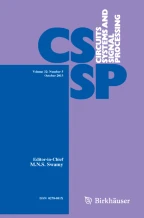Abstract
The paper provides a novel technique for designing tight frame wavelet filters through the use of Bernstein polynomials. The perfect-reconstruction conditions of tight wavelet frame filters are established by using parameters of the Bernstein polynomials. The desired number of vanishing moments can be easily achieved by setting the appropriate parameters of the Bernstein polynomial to zero. The filters are obtained by the spectral factorization method and constructed by the appropriate parameters. The design technique is flexible in that it allows low-pass filters and high-pass filters with different characteristics to be designed easily.
Similar content being viewed by others
References
A.F. Abdelnour, I.W. Selesnick, Symmetric nearly shift-invariant tight frame wavelets. IEEE Trans. Signal Process. 53, 231–239 (2005)
L.T. Bruton, Low-sensitivity digital ladder filters. IEEE Trans. Circuits Syst. CAS-22, 168–176 (1975)
H. Caglar, A.N. Akansu, A generalized parametric PR-QMF design technique based on Bernstein polynomial approximation. IEEE Trans. Signal Process. 41, 2314–2321 (1993)
K.N. Chaudhury, M. Unser, On the shiftability of dual-tree complex wavelet transforms. IEEE Trans. Signal Process. 58, 221–232 (2010)
C.K. Chui, W. He, Compactly supported tight frames associated with refinable functions. Appl. Comput. Harmon. Anal. 8, 293–319 (2000)
C.K. Chui, W. He, J. Stöckler, Compactly supported tight and sibling frames with maximum vanishing moments. Appl. Comput. Harmon. Anal. 13, 224–262 (2002)
I. Daubechies, Ten Lectures on Wavelets, CBMS-NSF Regional Conference Series in Applied Mathematics, vol. 61 (SIAM, Philadelphia, 1992)
I. Daubechies, B. Han, A. Ron, Z.W. Shen, Framelets: MRA-based constructions of wavelet frames. Appl. Comput. Harmon. Anal. 14, 1–46 (2003)
P.J. Davis, Interpolation and Approximation (Ginn-Blaisdell, Waltham, 1963)
B. Gold, C.M. Rader, Digital Processing of Signals (Lincoln Lab, Massachusetts Institute of Technology, Boston, 1965), p. 95
B. Han, Symmetric orthonormal scaling functions and wavelets with dilation factor 4. Adv. Comput. Math. 8, 221–247 (1998)
B. Han, Matrix extension with symmetry and applications to symmetric orthonormal complex M-wavelets. J. Fourier Anal. Appl. 15, 684–705 (2009)
B. Han, Compactly supported orthonormal complex wavelets with dilation 4 and symmetry. Appl. Comput. Harmon. Anal. 26, 422–431 (2009)
B. Han, Q. Mo, Tight wavelet frames generated by three symmetric B-spline functions with high vanishing moments. Proc. Am. Math. Soc. 132, 77–86 (2004)
B. Han, Q. Mo, Symmetric MRA tight wavelet frames with three generators and high vanishing moments. Appl. Comput. Harmon. Anal. 18, 67–93 (2005)
Q.T. Jiang, Parameterizations of masks for tight affine frames with two symmetric/antisymmetric generators. Adv. Comput. Math. 18, 247–268 (2003)
N. Kingsbury, Complex wavelets for shift invariant analysis and filtering of signals. Appl. Comput. Harmon. Anal. 10, 234–253 (2001)
W. Lawton, S.L. Lee, Z.W. Shen, Stability and orthonormality of multivariate refinable functions. SIAM J. Math. Anal. 28, 999–1014 (1997)
A. Petukhov, Explicit construction of framelets. Appl. Comput. Harmon. Anal. 11, 313–327 (2001)
A. Petukhov, Symmetric framelets. Constr. Approx. 19, 309–328 (2003)
L.R. Rajagopal, S.C. Dutta Roy, Design of maximally flat FIR filters using the Bernstein polynomial. IEEE Trans. Circuits Syst. 34, 1587–1590 (1987)
A. Ron, Z.W. Shen, Affine systems in L 2(R d): the analysis of the analysis operator. J. Funct. Anal. 148, 408–447 (1997)
I.W. Selesnick, Smooth wavelet tight frames with zero moments. Appl. Comput. Harmon. Anal. 10, 163–181 (2000)
I.W. Selesnick, A.F. Abdelnour, Symmetric wavelet frames with two generators. Appl. Comput. Harmon. Anal. 17, 211–225 (2004)
I.W. Selesnick, R.G. Baraniuk, N.G. Kingsbury, The dual-tree complex wavelet transform. IEEE Signal Process. Mag. 22, 123–151 (2005)
D.B.H. Tay, Zero-pinning the Bernstein polynomial: a simple design technique for orthonormal wavelets. IEEE Signal Process. Lett. 12, 835–838 (2005)
D.B.H. Tay, ETHFB: a new class of even-length biorthogonal wavelet filters for Hilbert pair design. IEEE Trans. Circuits Syst. I 55, 1580–1588 (2008)
D.B.H. Tay, Design of orthonormal Hilbert-pair of wavelets using zero-pinning. Signal Process. 90, 866–873 (2010)
H. Wang, L. Peng, Parameterizations of univariate wavelet tight frames with short support. Commun. Nonlinear Sci. Numer. Simul. 11, 663–677 (2006)
Acknowledgements
This work was supported in part by the China National Natural Science Foundation under Contract 60972089. The authors would like to express our deep thanks to Nick Kingsbury and the reviewers for their very helpful suggestions, which greatly improved the quality of this paper.
Author information
Authors and Affiliations
Corresponding author
Rights and permissions
About this article
Cite this article
Zhao, P., Zhao, C. Four-Channel Tight Wavelet Frames Design Using Bernstein Polynomial. Circuits Syst Signal Process 31, 1847–1861 (2012). https://doi.org/10.1007/s00034-012-9412-3
Received:
Revised:
Published:
Issue Date:
DOI: https://doi.org/10.1007/s00034-012-9412-3
